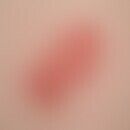Synonym(s)
DefinitionThis section has been translated automatically.
Frequent (most frequent tumor of the skin at all), occurring in single or multiple, benign, initially flat, with longer duration of existence also clearly exophytic, verrucous, benign, fibro-epithelial neoplasia, which occurs more frequently with increasing age (classic feature of aging skin) and can represent a cosmetic problem with multiple occurrences. Since seborrheic keratosis is usually dark in color, it represents the most important differential diagnosis (to be proven daily) to malignant melanoma .
ClassificationThis section has been translated automatically.
Clinical subdivision of seborrheic keratoses (SK):
- Lentiginous type (flat, pigmented, non-pigmented (early) SK).
- Plaque type (flat raised, pigmented or non-pigmented SK)
- Papillomatous type (pigmented papillomatous SK)
- Filiform type (pigmented or non-pigmented filiform SK)
- Special types:
- SK-gigantea
- Melanoacanthoma type (black, flat raised or papillomatous SK)
- Stukkokeratosis type (flat, white-gray SK of the extremities)
- Eruptive SK(Leser-Trélat syndrome).
Histologic differentiation of seborrheic keratosis:
- 6 different types can be distinguished by fine tissue, and the individual types often overlap histologically (see histology below):
- Hyperkeratotic type
- Acanthotic type
- Reticular/adenoid type
- Clonal type
- Irritated type
- Melanoacanthoma.
You might also be interested in
Occurrence/EpidemiologyThis section has been translated automatically.
There are few statistically relevant epidemiological data regarding prevalence, gender distribution (men/women equally distributed?), skin color (light-skinned population more affected?) or geographical distribution.
Clinical experience shows that beyond the age of 60 the prevalence is >90%.
EtiopathogenesisThis section has been translated automatically.
Familial predisposition can be assumed. Possible autosomal dominant mode of inheritance. In a high percentage seb. Warts 1 or even 2 mutations (FGFR3-, PIK3CA-, KRAS-, HRAS- (see below Ras), EGFR-, AKT1-Oncogene see below. Growth factors) have been demonstrated in the major oncogenes of carcinoma induction. The question why development of malignancy is practically excluded remains unanswered at present.
ManifestationThis section has been translated automatically.
Occurring mainly in older age. Rarely seen in individuals < 30 years of age.
LocalizationThis section has been translated automatically.
Clinical featuresThis section has been translated automatically.
Sharply delimited, solitary, but usually multiple, disseminated, roundish to oval, a few millimeters to several centimeters in size, soft or soft-elastic, raised, gray-brown or also black structures with a fissured, warty surface, interspersed with black indentations(horny plugs, which are very well visualized by light microscopy). In an early stage of development, seborrheic keratoses appear as flat, skin-colored or gray-brown spots or plaques with a matte surface.
It is not uncommon for smaller or larger pieces of tissue to detach due to mechanical influences (e.g., rubbing off). Complete detachment is also possible. Larger seborrheic warts appear as if "attached" to the skin.
Passive itching may be present. Patients sometimes point out a wart identical to other seborrheic warts that would itch repeatedly.
In intertriginous areas, seborrheic keratoses are found as smooth-scoured, flat, often skin-colored plaques, sometimes weeping.
By reflected light microscopy, the seb. Keratoses show different images. The detection of horny beads is characteristic.
Pedunculated VS are found mainly in the intertriginous spaces.
Clinically, the flat seborrheic keratoses include the differently pigmented verruca-plana-like SK (see below seborrheic warts, verruca-plana-like), which are mainly observed on the dorsum of the hands (frequently also in younger individuals).
HistologyThis section has been translated automatically.
- Hyperkeratotic type: Sawtooth-like surface relief with distinct papillomatosis. Voluminous orthohyperkeratosis as well as focal and parahyperkeratosis are present. Moderately pronounced acanthosis with predominant occurrence of spindle-cell differentiated keratinocytes. Missing or only moderate hyperpigmentation. No horn or pseudohorn cysts.
- Acanthotic type (most common histological type): Massive homogeneous or reticular acanthosis with moderate or slight hyperkeratosis and papillomatosis. Numerous horn and pseudohorn cysts. Predominantly basaloid differentiated tumor parenchyma with distinct hyperpigmentation especially in the dermo-epidermal junctional zone. In the dermis there is often a thin lympho-histiocytic infiltrate.
- Adenoid/reticular type: The reticular type is also called adenoid type, although there is no glandular etiology. The histological picture is due to a reticular acanthosis in moderate or mild hyperkeratosis and papillomatosis. The interconnected epithelial strands are 2-3 rows. Hardly any corneal and pseudohorn cysts. Predominantly basaloid differentiated tumor cells. Clear hyperpigmentation of the tumor parenchyma with accentuation of the dermoepidermal junctional zone. The dermis often shows a thin lympho-histiocytic infiltrate.
- Clonal type: Severe irregular acanthosis and papillomatosis in orthohyperkeratosis. Within the spindle-cell differentiated tumor parenchyma there are clearly separated nests with basaloid or also paler larger nests (see also Borst-Jadassohn phenomenon).
- Irritated type: Proliferation of spindle-cell differentiated eosinophilic squamous epithelia, partly in onion-skin-like or vertebral arrangement. Basaloid formations are usually completely absent. Occasionally there are also dyskeratoses. Rarely acantholysis.
- Melanoacanthoma: Image of the acanthotic type of Verruca seborrhoica with homogeneous proliferation of mature, predominantly basaloid epithelial cells. Little or no hyperkeratosis. Numerous melanocytes distributed over all layers of the tumor. Dense layer of melanophages in the dermis. Small, spongy inflammatory infiltrate.
Differential diagnosisThis section has been translated automatically.
TherapyThis section has been translated automatically.
Remember! In case of suspicion of reader-Trélat syndrome: Extensive tumour search.
In cosmetically disturbing cases or to exclude other pigmentary tumours, removal with a sharp spoon, with an electric snare or by means of Erbium-Yag orCO2 laser. Caution! Histology is not possible in blind procedures. Subsequent wound treatment, e.g. with antiseptic ointments such as polyvidon-iodine ointment(e.g. R204, Braunovidon ointment) or ointments containing antibiotics (e.g. Fucidine ointment) and fatty gauze (e.g. Oleo-Tuell, Jelonet) and a loose dressing. Alternatively, drying disinfectant topicals such as 0.5% methylrosanilinium chloride solution.
Progression/forecastThis section has been translated automatically.
Note(s)This section has been translated automatically.
- The term "seborrheic" misleadingly refers to "seborrhea". However, the seborrheic wart has nothing to do with the sebaceous gland or its function. Rather, the term refers to the greasy/waxy-like consistency; this is particularly evident in flat abrasion.
- A special clinical form is stucco keratosis. Histologically, the hyperkeratotic type is found.
- The eruptive occurrence of multiple verrucae seborrhoicae is known as paraneoplastic syndrome(Leser-Trélat syndrome) and requires an intensive tumor search.
- Familial occurrence of multiple verrucae seborrhoicae, especially in people of color, is known as dermatosis papulosa nigra.
- The diagnosis "seborrheic keratosis" is on the one hand a "simple" diagnosis for the experienced physician. Most important, however, is its reliable differentiation from a malignant melanoma. This differentiation cannot be made by a non-physician with the necessary certainty. In this respect, lay diagnoses or remote diagnoses of any kind are only to be regarded as "provisional" and not reliable. In any case, they require qualified verification by a proven expert.
LiteratureThis section has been translated automatically.
- Argenziano G et al (2003) Melanoma simulating seborrheic keratosis: a major dermoscopy pitfall. Arch Dermatol 139: 389-391
- Braun RP et al (2002) Dermoscopy of pigmented seborrheic keratosis: a morphological study. Arch Dermatol 138: 1556-1560
- Duque MI (2003) Frequency of seborrheic keratosis biopsies in the United States: a benchmark of skin lesion care quality and cost effectiveness. Dermatol Surgery 29: 796-801
- Hafner C et al (2010) Multiple oncogenic mutations and clonal relationship in spatially distinct benign human epidermal tumors. Proc Natl Acad Sci 107:20780-20785
- Inamadar AC, Palit A (2003) Eruptive seborrhoeic keratosis in human immunodeficiency virus infection: a coincidence or 'the sign of reader trelat'? Br J Dermatol 149: 435-436
- Izikson L et al (2002) Prevalence of melanoma clinically resembling seborrheic keratosis: analysis of 9204 cases. Arch Dermatol 138: 1562-1566
- King R (2003) Desmoplastic seborrheic keratosis. At J Dermatopathol 25: 210-214
- Kwon OS et al (2003) Seborrheic keratosis in the Korean males: causative role of sunlight. Photodermatol Photoimmunol Photomed 19: 73-80
- Miracco C et al (2003) Carcinoma with eccrine differentiation arising in a seborrhoeic keratosis. Br J Dermatol 148: 831-833
- Nakamura S, Nishioka K (2003) Enhanced expression of p16 in seborrhoeic keratosis; a lesion of accumulated senescent epidermal cells in G1 arrest. Br J Dermatol 149: 560-565
- Nakamura H et al (2001) Clonal nature of seborrheic keratosis demonstrated by using the polymorphism of the human androgen receptor locus as a marker. J Invest Dermatol 116: 506-510
- Pesce C, Scalora S (2000) Apoptosis in the areas of squamous differentiation of irritated seborrheic keratosis. J Cutan cathode 27: 121-123
Incoming links (64)
Acanthokeratosis, benign; Acanthomas, disseminated epidermolytic; Acanthopapilloma; Acuminate condyloma; Basal cell carcinoma pigmented; Basal cell papilloma; Borst-jadassohn epithelioma; Borst-jadassohn phenomenon; Clear cell lacanthoma; Cornu cutaneum; ... Show allOutgoing links (25)
Acanthosis nigricans maligna; Angiokeratomas (overview); Antiseptic; Basal cell carcinoma (overview); Borst-jadassohn phenomenon; Bowen's disease; Cutaneous paraneoplastic syndromes (overview); Dyskeratosis; Gentian violet; Growth factors; ... Show allDisclaimer
Please ask your physician for a reliable diagnosis. This website is only meant as a reference.
















































